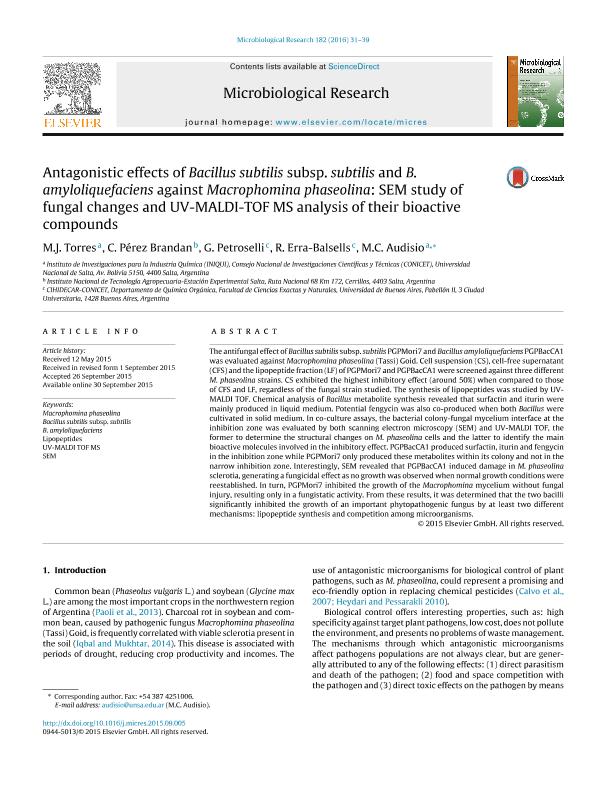Mostrar el registro sencillo del ítem
dc.contributor.author
Torres, María Julia

dc.contributor.author
Perez Brandan, Carolina Gabriela

dc.contributor.author
Petroselli, Gabriela

dc.contributor.author
Erra Balsells, Rosa

dc.contributor.author
Audisio, Marcela Carina

dc.date.available
2018-04-19T18:51:36Z
dc.date.issued
2016-01
dc.identifier.citation
Torres, María Julia; Perez Brandan, Carolina Gabriela; Petroselli, Gabriela; Erra Balsells, Rosa; Audisio, Marcela Carina; Antagonistic effects of Bacillus subtilis subsp. subtilis and B. amyloliquefaciens against Macrophomina phaseolina: SEM study of fungal changes and UV-MALDI-TOF MS analysis of their bioactive compounds; Elsevier Gmbh; Microbiological Research; 182; 1-2016; 31-39
dc.identifier.issn
0944-5013
dc.identifier.uri
http://hdl.handle.net/11336/42717
dc.description.abstract
The antifungal effect of Bacillus subtilis subsp. subtilis PGPMori7 and Bacillus amyloliquefaciens PGPBacCA1 was evaluated against Macrophomina phaseolina (Tassi) Goid. Cell suspension (CS), cell-free supernatant (CFS) and the lipopeptide fraction (LF) of PGPMori7 and PGPBacCA1 were screened against three different M. phaseolina strains. CS exhibited the highest inhibitory effect (around 50%) when compared to those of CFS and LF, regardless of the fungal strain studied. The synthesis of lipopeptides was studied by UV-MALDI TOF. Chemical analysis of Bacillus metabolite synthesis revealed that surfactin and iturin were mainly produced in liquid medium. Potential fengycin was also co-produced when both Bacillus were cultivated in solid medium. In co-culture assays, the bacterial colony-fungal mycelium interface at the inhibition zone was evaluated by both scanning electron microscopy (SEM) and UV-MALDI TOF, the former to determine the structural changes on M. phaseolina cells and the latter to identify the main bioactive molecules involved in the inhibitory effect. PGPBacCA1 produced surfactin, iturin and fengycin in the inhibition zone while PGPMori7 only produced these metabolites within its colony and not in the narrow inhibition zone. Interestingly, SEM revealed that PGPBacCA1 induced damage in M. phaseolina sclerotia, generating a fungicidal effect as no growth was observed when normal growth conditions were reestablished. In turn, PGPMori7 inhibited the growth of the Macrophomina mycelium without fungal injury, resulting only in a fungistatic activity. From these results, it was determined that the two bacilli significantly inhibited the growth of an important phytopathogenic fungus by at least two different mechanisms: lipopeptide synthesis and competition among microorganisms.
dc.format
application/pdf
dc.language.iso
eng
dc.publisher
Elsevier Gmbh

dc.rights
info:eu-repo/semantics/openAccess
dc.rights.uri
https://creativecommons.org/licenses/by-nc-nd/2.5/ar/
dc.subject
Macrophomina Phaseolina
dc.subject
Bacillus Subtilis Subsp. Subtilis; B. Amyloliquefaciens
dc.subject
Lipopeptides
dc.subject
Uv-Maldi Tof Ms
dc.subject
Sem
dc.subject.classification
Otras Ciencias Químicas

dc.subject.classification
Ciencias Químicas

dc.subject.classification
CIENCIAS NATURALES Y EXACTAS

dc.title
Antagonistic effects of Bacillus subtilis subsp. subtilis and B. amyloliquefaciens against Macrophomina phaseolina: SEM study of fungal changes and UV-MALDI-TOF MS analysis of their bioactive compounds
dc.type
info:eu-repo/semantics/article
dc.type
info:ar-repo/semantics/artículo
dc.type
info:eu-repo/semantics/publishedVersion
dc.date.updated
2018-04-13T14:33:59Z
dc.journal.volume
182
dc.journal.pagination
31-39
dc.journal.pais
Alemania

dc.description.fil
Fil: Torres, María Julia. Consejo Nacional de Investigaciones Científicas y Técnicas. Centro Científico Tecnológico Conicet - Salta. Instituto de Investigaciones para la Industria Química. Universidad Nacional de Salta. Facultad de Ingeniería. Instituto de Investigaciones para la Industria Química; Argentina
dc.description.fil
Fil: Perez Brandan, Carolina Gabriela. Consejo Nacional de Investigaciones Científicas y Técnicas; Argentina. Instituto Nacional de Tecnología Agropecuaria. Centro Regional Salta-Jujuy. Estación Experimental Agropecuaria Salta; Argentina
dc.description.fil
Fil: Petroselli, Gabriela. Consejo Nacional de Investigaciones Científicas y Técnicas. Oficina de Coordinación Administrativa Ciudad Universitaria. Centro de Investigaciones en Hidratos de Carbono. Universidad de Buenos Aires. Facultad de Ciencias Exactas y Naturales. Centro de Investigaciones en Hidratos de Carbono; Argentina
dc.description.fil
Fil: Erra Balsells, Rosa. Consejo Nacional de Investigaciones Científicas y Técnicas. Oficina de Coordinación Administrativa Ciudad Universitaria. Centro de Investigaciones en Hidratos de Carbono. Universidad de Buenos Aires. Facultad de Ciencias Exactas y Naturales. Centro de Investigaciones en Hidratos de Carbono; Argentina
dc.description.fil
Fil: Audisio, Marcela Carina. Consejo Nacional de Investigaciones Científicas y Técnicas. Centro Científico Tecnológico Conicet - Salta. Instituto de Investigaciones para la Industria Química. Universidad Nacional de Salta. Facultad de Ingeniería. Instituto de Investigaciones para la Industria Química; Argentina
dc.journal.title
Microbiological Research

dc.relation.alternativeid
info:eu-repo/semantics/altIdentifier/url/https://www.sciencedirect.com/science/article/pii/S0944501315300094
dc.relation.alternativeid
info:eu-repo/semantics/altIdentifier/doi/http://dx.doi.org/10.1016/j.micres.2015.09.005
Archivos asociados
